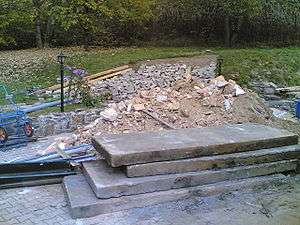Demolition waste

Demolition waste is waste debris from destruction of a building. The debris varies from insulation, electrical wiring, rebar, wood, concrete, and bricks. It also may contain lead, asbestos or different hazardous materials.[1]
Certain components of demolition waste such as plasterboard are hazardous once landfilled. Plasterboard is broken down in landfill conditions releasing hydrogen sulfide, a toxic gas.
There is the potential to recycle many elements of demolition waste. Often roll-off containers are used to transport the waste. Rubble can be crushed and reused in construction projects. Waste wood can also be recovered and recycled.
Government or local authorities often make rules about how much waste should be sorted before it is hauled away to landfills or other waste treatment facilities. Some hazardous materials may not be moved, or demolition begun, before the authorities have ascertained that safety guidelines and restrictions have been followed. Among their concerns would be the proper handling and disposal of such toxic elements as lead, asbestos or radioactive materials.
